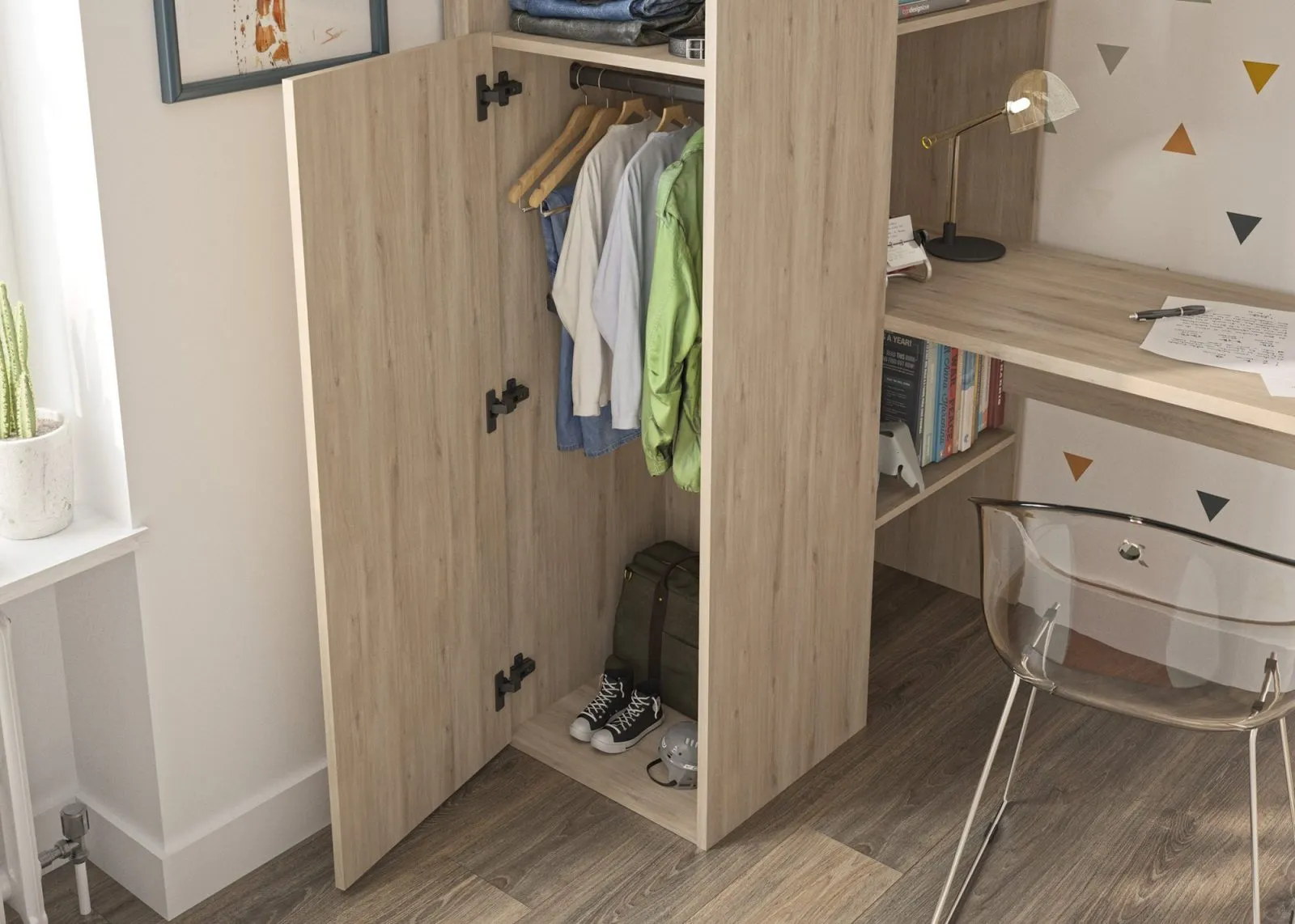Mezzanines offer a clever solution for maximizing space without undertaking a full-blown expansion. However, determining the ideal height for your mezzanine requires careful consideration of safety regulations, spatial harmony, and design aspirations. This comprehensive guide delves into the intricacies of optimizing mezzanine height to help you create a functional and visually appealing addition to your space.
Mezzanine Height: Finding that Sweet Spot
Determining the ideal mezzanine height is a delicate balancing act. It’s about maximizing headroom without compromising on aesthetics or structural integrity. Let’s explore the key factors that influence this crucial design element:
Building Codes and Headroom: The Non-Negotiables
Building codes serve as the blueprint for construction, ensuring safety and adherence to established standards. When it comes to mezzanines, height regulations are paramount. These codes typically mandate a minimum clear height of 7 feet both above and below the mezzanine floor.
This requirement serves several purposes:
- Preventing Head Injuries: Adequate headroom ensures users can move comfortably without the risk of bumping their heads.
- Facilitating Furniture Movement: Sufficient clearance simplifies the process of moving furniture and equipment onto and off of the mezzanine.
- Meeting Fire Safety Standards: A minimum height allows for smoke and heat to rise in the event of a fire, providing crucial time for evacuation.
If you are unsure about the minimum free height required for mezzanines, consult your local building codes.
Golden Ratio for a Stunning Mezzanine
Beyond safety, aesthetics play a vital role in mezzanine design. A well-proportioned mezzanine seamlessly integrates with the existing space, enhancing its visual appeal. Aim for a mezzanine height that’s approximately one-third to one-half of the total ceiling height. This ratio creates a sense of balance, preventing the mezzanine from feeling cramped or overwhelming the room.
Strength and Safety: The Foundation of a Sound Mezzanine
Mezzanine height directly impacts its structural integrity. Since a mezzanine effectively adds an extra floor, it must be engineered to withstand the intended load. This is where the expertise of structural engineers is essential.
Engineers perform meticulous calculations, factoring in:
- Weight Limits: Determining the maximum load the mezzanine can safely support.
- Potential Deflection: Assessing the degree to which the mezzanine floor may bend or sag under load.
- Materials: The type and strength of materials used in the mezzanine’s construction (e.g., steel, concrete, wood).
By carefully analyzing these factors, engineers ensure your mezzanine is built to last and meets the highest safety standards.
Making the Most of Your Mezzanine: Functionality Meets Versatility
A well-designed mezzanine transcends its role as merely additional square footage. It unlocks a world of possibilities, enhancing both functionality and versatility. Here’s how:
- Double Your Space, Double the Possibilities: Mezzanines provide a dedicated area for various needs, freeing up valuable floor space below:
- Storage: Create a dedicated storage area for inventory, equipment, or seasonal items.
- Home Office: Design a private and inspiring loft office overlooking your living space.
- Retail Expansion: Add a dynamic, split-level dimension to your retail store.
- Flexible Design for Changing Needs: Incorporate design elements that adapt to your evolving requirements:
- Operable Walls: Transform an open-concept mezzanine into private rooms as needed.
Don’t Go It Alone: Enlist the Experts
Embarking on a mezzanine project is an exciting endeavor, but it’s crucial to seek guidance from qualified professionals:
- Architects: Architects bring your vision to life, ensuring the mezzanine harmonizes with your existing space.
- Engineers: Structural engineers ensure the mezzanine is safe, sound, and compliant with building codes.
If you are looking for an innovative and experienced architectural design company to design your mezzanine floor, don’t hesitate to contact us.
What are the Building Code Requirements for Mezzanine Height?
Before diving into the design and functionality of your mezzanine, it’s crucial to understand the building code requirements that govern their construction. These codes are in place to ensure safety, accessibility, and structural integrity.
Here’s a breakdown of key height regulations:
- Headroom – Gotta Stand Tall! Building codes mandate a minimum clear height of 7 feet both above and below the mezzanine floor to prevent head injuries and ensure comfortable movement.
- Area Limits – Keeping it Roomy! The total floor area of your mezzanine cannot exceed one-third of the room’s floor area. This rule ensures adequate open space for air circulation and prevents a cramped feeling.
- Fire Safety First! Mezzanine height is intrinsically linked to fire safety. Sufficient height allows heat and smoke to rise, providing occupants with valuable time to evacuate. It also ensures the effectiveness of fire suppression systems, such as sprinklers.
- Stacking Mezzanines? Mind the Ratio! If you envision multiple mezzanine levels, the combined floor space of all levels cannot exceed one-third of the floor space beneath them. This rule safeguards the building’s structural integrity and prevents overloading.
- Beyond the Basics Building codes can vary depending on your location and the specifics of your project. It’s essential to consult with a qualified architect or engineer to ensure your mezzanine design complies with all local regulations.
How Does Mezzanine Height Impact Design and Functionality?
Mezzanine height is more than just a numerical value; it significantly influences the overall design and functionality of your space. Here’s how:
Space Optimization and Functionality – Making the Most of Your Mezzanine
The height of your mezzanine directly impacts its usability.
- Storage Galore: A taller mezzanine offers ample vertical space for storage, allowing you to maximize capacity without encroaching on the floor area below.
- Dedicated Work Zones: Create functional and private work zones, such as offices, meeting rooms, or breakout spaces.
- Enhanced Traffic Flow: A well-placed mezzanine can improve circulation by defining pathways and reducing congestion on the ground level.
Building Strong and Staying Safe: Structural Considerations
Structural integrity is paramount. Here’s how mezzanine height plays a crucial role:
- Load-Bearing Capacity: The height of your mezzanine influences its ability to support weight. Engineers calculate the maximum load capacity to ensure safety.
- Headroom and Clearance: Adequate headroom ensures comfortable and safe movement.
- Code Compliance: Mezzanine height must adhere to building codes to ensure safety and prevent future complications.
Design and Harmony: Where Function Meets Flair
Aesthetics are essential for creating a cohesive and visually appealing space.
- Visual Impact: The height of your mezzanine influences the overall ambiance. A soaring mezzanine creates a sense of grandeur, while a cozier height fosters intimacy.
- Natural Light Optimization: The mezzanine’s height can affect the amount of natural light that reaches the floor below.
- Architectural Harmony: The mezzanine should complement your building’s existing architecture, creating a seamless and harmonious design.
What is the Ideal Mezzanine Height for My Space?
Determining the ideal mezzanine height for your unique needs requires careful consideration of several factors:
Building Codes and Keeping Things Safe
Building codes dictate a minimum height of 7 feet above and below the mezzanine floor. However, aiming for a height that’s one-third to one-half of your ceiling height often results in a more balanced and spacious feel.
Space: It’s Not Just About Height!
Consider the footprint of your mezzanine. Building codes usually limit the mezzanine area to one-third of the room’s floor space to ensure sufficient circulation and safety.
Fire Safety and Your Mezzanine
Mezzanines must comply with fire codes, ensuring safe exits, clear access for firefighters, and proper smoke ventilation.
What Are You Using Your Mezzanine For?
The intended use of your mezzanine plays a significant role in determining the ideal height. Storage mezzanines may benefit from taller ceilings, while offices or retail spaces might prioritize a more open and interactive feel. Learn more about the variables that influence mezzanine floor height for your building project.
Strength and Stability: The Importance of Structure
The height of your mezzanine directly impacts its strength and stability. Engineers will calculate the load-bearing capacity based on the chosen height and materials.
In conclusion, optimizing mezzanine height involves finding the perfect balance between safety, functionality, and design. By carefully considering these factors, seeking expert guidance, and adhering to building codes, you can create a mezzanine that not only elevates your space but also enhances its overall value and appeal.
- Small Corner Kitchen Ideas: Maximize Style In Tight Spaces - January 1, 2026
- Kitchen Counter Corner Ideas: Style Your Awkward Angles Now - December 31, 2025
- Best Finish for Butcher Block Countertops: Choosing the Right Option - December 30, 2025










